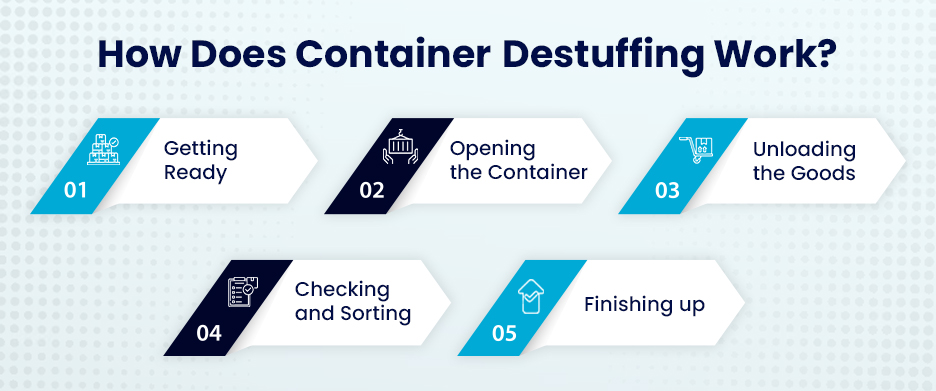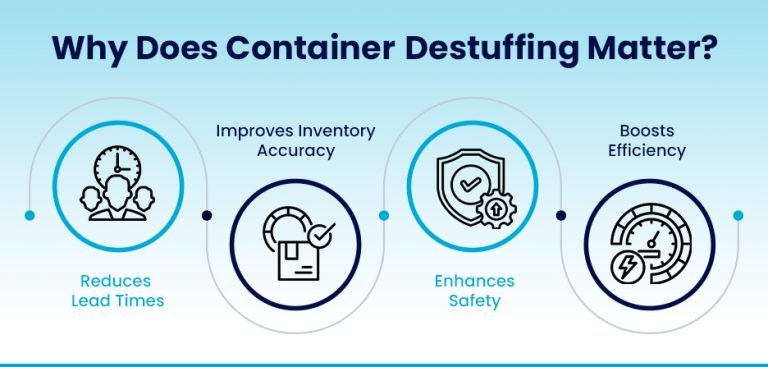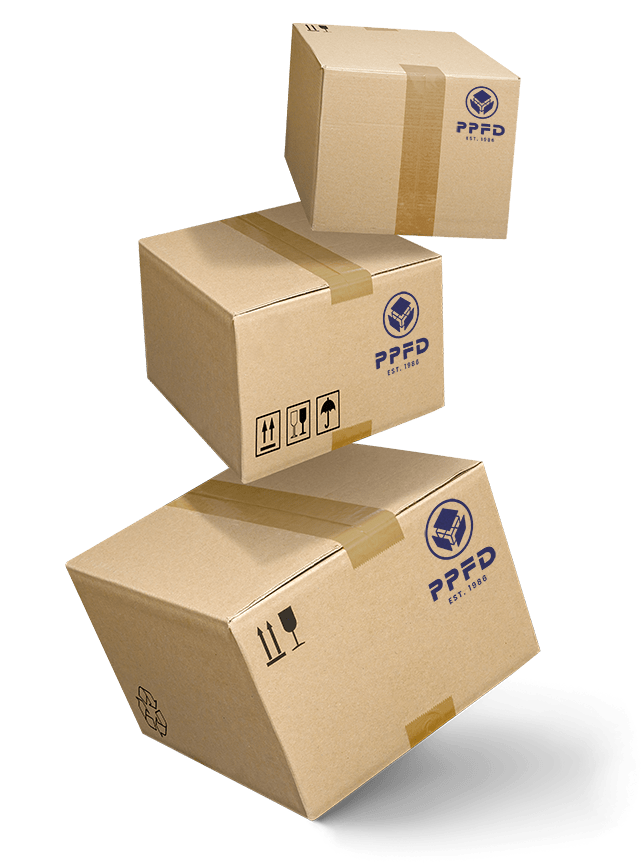
Have you ever thought about what happens the moment a shipping container arrives at a warehouse? It’s easy to assume it’s just about opening doors and moving boxes, but it’s not that simple. Some items are heavy, some fragile, and one wrong move can cause delays or damage. That’s why container destuffing is such a crucial step.
It’s about more than unloading; it’s about doing it safely, efficiently, and in an organized way so your business keeps running smoothly. In this guide, we’ll break down what container destuffing is, why it matters, the challenges you might face, and practical ways to handle it.
When a shipping container shows up at your warehouse, it’s like a big box packed with stuff from all over the world. Container destuffing is simply taking everything out carefully so it’s ready to use, store, or sell. It’s the first step that keeps everything running smoothly.
Doing it right matters; a wrong move can damage products or slow down your whole operation. That’s why careful handling and organization are key from the very start.

Container destuffing is a pretty organized process that keeps everything safe and makes sure nothing gets lost or damaged. Here’s how it usually goes down:
First things first, when a container arrives, the team checks the paperwork and seals. Why? To make sure nothing’s been tampered with during the trip. Then, they gather the right tools, like forklifts, pallet jacks, conveyors, you name it, depending on what’s inside.
The doors are opened carefully. No one wants boxes tipping over or fragile items getting damaged. The team often checks the stability of stacked goods and inspects for visible issues before fully opening everything. This step prevents accidents and protects the cargo.
Now comes the “moving day” part. Items are pulled out in an organized order, usually last-in, first-out. Heavier items, often loaded first at the bottom, are handled carefully and usually come out last. Using the right equipment ensures everything moves safely and efficiently.
Every item gets a quick check against the shipping list. Any missing or damaged items are flagged immediately. Then, goods are sorted by type, destination, or priority, so they can be sent to warehouses, stores, or directly to customers without confusion. This step keeps everything organized and easy to track.
Once the container is empty, it gets a final check for damage and a quick clean-up. This ensures it’s ready for the next shipment without delays or issues. A little care here keeps the process smooth and prevents problems down the line.

Container destuffing might seem just another warehouse task to you, but to be honest, it is what decides how smoothly your entire supply chain runs. If it is done properly, it can work wonders. Here’s why it matters so much:
The faster your goods are unloaded, the sooner they can move to their next destination. Whether that’s a store shelf, a warehouse rack, or straight to the customer’s door. Quick destuffing helps cut down the time products spend just sitting around, which means your business can react faster to orders and keep up with demand.
When every box is unloaded and checked properly, it’s much easier to know exactly what you have in stock. That means fewer surprises like missing items or wrong counts later. Accurate inventory helps businesses plan better, restock on time, and avoid both over-ordering and running out of products.
Unloading a container might not sound risky, but when heavy boxes or unstable stacks are involved, one wrong move can cause accidents. Careful destuffing keeps both the goods and the workers safe. Proper equipment, good organization, and trained staff go a long way in preventing injuries and damage.
When the unloading process is organized, everything else runs smoother too. Workers can move goods faster, warehouse space is used more smartly, and there’s less chaos on the floor. Over time, that kind of efficiency saves money, energy, and a lot of unnecessary stress.
As with any other process, even container destuffing has its own hurdles.
Not every shipment is simple to unload. Some containers carry bulky machinery or fragile goods like glass and electronics that need extra care. One wrong move can cause serious damage or injury. That’s why proper equipment, like forklifts, dollies, and protective gear, along with skilled handling, is a must.
Warehouses and unloading zones often have limited space to work with. Trying to move large pallets or organize goods in a cramped area can slow everything down. It also increases the risk of accidents or product mix-ups. Smart layout planning and efficient use of space can make a big difference here.
Destuffing isn’t light work; it’s physically demanding and time-consuming. Workers have to lift, move, and organize goods for hours, sometimes in tough weather conditions. Without the right training or equipment, fatigue and mistakes can easily set in. Investing in proper tools and well-trained staff helps make the job safer and faster.
At the end of the day, overcoming these challenges takes good planning, the right gear, and a well-coordinated team. When all three come together, container destuffing becomes a smooth, efficient part of the supply chain rather than a bottleneck

To turn container destuffing into a smooth, efficient process, you must follow some tips that are mentioned below:
Always start with what’s easiest to reach and move toward the more difficult items. This avoids unnecessary lifting or rearranging mid-process. A clear unloading plan also helps prevent confusion and keeps the workflow steady, especially when multiple people are involved.
Don’t rely on manpower alone. Tools make unloading faster and safer, especially for heavy or oversized goods. The right equipment not only reduces strain on workers but also helps prevent damage to the cargo.
Before unloading, take a few minutes to check the container’s condition and the goods inside. Look for any dents, leaks, or broken seals. Catching these issues early helps document damage properly and prevents problems later during sorting or shipping.
Once items are out of the container, sort them right away based on where they’re headed or how quickly they need to move. Keeping similar products together saves time during inventory checks. Plus, a tidy and well-labelled staging area helps avoid mix-ups and misplaced goods.
Even the best equipment won’t help if your team doesn’t know how to use it safely. Regular training ensures everyone understands proper lifting techniques, equipment use, and safety protocols. Well-trained workers are more confident, efficient, and less likely to make costly mistakes.
So many businesses prefer to manage container destuffing on their own. But at times, when things seem a bit hard or unmanageable, they hand it over to the experts.
Here are a few times when it’s worth considering:
If containers are arriving faster than your team can unload them, outsourcing can be the best choice. High shipment volumes often require more hands, equipment, and coordination than an in-house crew can manage. A logistics partner can help you stay on schedule and prevent bottlenecks during busy periods.
Some shipments, like fragile, oversized, or hazardous items, need extra attention and the right tools to handle them safely. Experienced logistics providers are trained for these situations, so you can rest easy knowing your goods are being handled properly from start to finish.
If warehouse space is tight or your team is already stretched thin, outsourcing destuffing can help lighten the load. It frees up valuable space and allows your staff to focus on core operations, like order processing or inventory management, instead of time-consuming unloading work.
Outsourcing isn’t about losing control; it’s about making smarter use of your resources. With the right logistics partner, container destuffing becomes faster, safer, and far less stressful, keeping your supply chain running at its best.
At PPFD, we don’t just unload containers; we take the stress out of the entire process. Our team blends hands-on experience with smart automation to make sure every shipment is handled with care and precision from the moment it arrives.
Whether it’s a high-volume delivery or a sensitive cargo, we make sure everything is unpacked, inspected, and organized the right way.
Every container is different, and we treat it that way. Our mix of trained professionals and automated systems helps us unload quickly and safely, no shortcuts, no delays.
Before anything moves forward, our team inspects each shipment carefully. If there’s even a hint of damage, it’s documented and reported instantly, so you always know exactly what’s happening with your goods.
We don’t just unload; we organize. Items are sorted and stacked neatly on pallets, ready for storage or distribution. It’s all about making the next step faster and simpler.
With our Warehouse Management System (WMS), you get live updates as your inventory is processed. No waiting, no guessing, just full visibility from start to finish.
At PPFD, container destuffing isn’t a routine; it’s a precision process designed to save you time, protect your cargo, and keep your operations running seamlessly.
Container destuffing may seem like just another step in the supply chain, but as we’ve seen, it plays a critical role in keeping your operations smooth, safe, and efficient.
From careful unloading and accurate inventory checks to overcoming challenges and implementing best practices, every detail matters.
Whether you handle it in-house or partner with experts like PPFD, the goal is the same: protect your goods, save time, and keep your supply chain running without hiccups. When executed correctly, container destuffing doesn’t just move boxes; it moves your business forward.
It depends on the size of the container and the type of cargo. Small shipments can take just a couple of hours, while larger or fragile shipments may need a full day or more for careful unloading.
Destuffing is the first step in a warehouse’s workflow. From there, items are stored, tracked, and shipped efficiently. For a deeper look at how warehouses and distribution centres manage the entire process, check out our guide.
It’s a smart idea. Even with careful handling, accidents can happen. Insurance protects your goods and gives peace of mind during the unloading process.
Absolutely! Tools like warehouse management systems, scanners, and automated conveyors can track inventory in real time and make unloading faster, safer, and more organized.
Share :

get started
Our team is eager to partner with you and show why PPFD is the go-to choice for businesses aiming to streamline their logistics and distribution.
